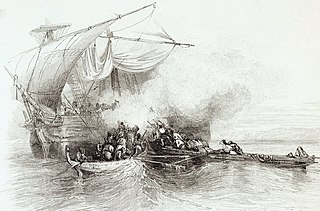Fifteen ships of the Royal Navy have been named HMS Enterprise while another was planned:

USS Hornet (CV-8), the seventh U.S. Navy vessel of that name, was a Yorktown-class aircraft carrier of the United States Navy.

In the 18th century and most of the 19th, a sloop-of-war in the Royal Navy was a warship with a single gun deck that carried up to eighteen guns. The rating system covered all vessels with 20 guns and above; thus, the term sloop-of-war encompassed all the unrated combat vessels, including the very small gun-brigs and cutters. In technical terms, even the more specialised bomb vessels and fireships were classed as sloops-of-war, and in practice these were employed in the sloop role when not carrying out their specialised functions.
Three ships of the United States Navy have been named Cabot, after the explorer John Cabot.

The third USS Hornet was a brig-rigged sloop-of-war in the United States Navy. During the War of 1812, she was the first U.S. Navy ship to capture a British privateer.

The first USS Argus, originally named USS Merrimack, was a brig in the United States Navy commissioned in 1803. She enforced the Embargo Act of 1807 and fought in the First Barbary War – taking part in the blockade of Tripoli and the capture of Derna – and the War of 1812. During the latter conflict, she had been audaciously raiding British merchant shipping in British home waters for a month, when the heavier British Cruizer-class brig-sloopHMS Pelican intercepted her. After a sharp fight during which Argus's captain, Master Commandant William Henry Allen, was mortally wounded, Argus surrendered when the crew of Pelican were about to board.
Eighteen ships of the Royal Navy have borne the name Hunter:
USS Plymouth was a sloop-of-war constructed and commissioned just prior to the Mexican–American War. She was heavily gunned, and traveled to Japan as part of Commodore Matthew C. Perry's effort to force Japan to open her ports to international trade. She also served in European and Caribbean waters and, later in her career, she was used to train midshipmen.

USS Vixen was a schooner in the United States Navy during the First Barbary War. Vixen was one of four vessels authorized by Congress on 28 February 1803. She was built at Baltimore, Maryland, in the spring of 1803; and launched on 25 June, Lieutenant John Smith in command.

The Mediterranean Squadron, also known as the Mediterranean Station, was part of the United States Navy in the 19th century that operated in the Mediterranean Sea. It was formed in response to the First and Second Barbary Wars. Between 1801 and 1818, the squadron was composed of a series of rotating squadrons. Later, squadrons were sent in the 1820s to the 1860s to suppress piracy, primarily in Greece and to engage in gunboat diplomacy. In 1865 the force was renamed the European Squadron.
Ten ships of the Royal Navy have borne the name HMS Mutine :

The Cruizer class was an 18-gun class of brig-sloops of the Royal Navy. Brig-sloops were the same as ship-sloops except for their rigging. A ship-sloop was rigged with three masts whereas a brig-sloop was rigged as a brig with only a fore mast and a main mast.
Thirty-nine vessels of the Royal Navy and its predecessors have borne the name Swallow, as has one dockyard craft, one naval vessel of the British East India Company, and at least two revenue cutters, all after the bird, the Swallow:
Twelve ships of the Royal Navy have been named HMS Otter, for the otter.
Fourteen ships and a shore establishment of the Royal Navy have borne the name Raven, after birds of the genus Corvus, particularly the common raven:
Ten ships of the Royal Navy have borne the name HMS Confiance:
Seventeen ships of the Royal Navy have borne the name HMS Dispatch, or the variant HMS Despatch:

Aegean Sea anti-piracy operations began in 1825 when the United States government dispatched a squadron of ships to suppress Greek piracy in the Aegean Sea. The Greek civil wars of 1824–1825 and the decline of the Hellenic Navy made the Aegean quickly become a haven for pirates who sometimes doubled as privateers.
Several vessels have born the name Dispatch:
This page is based on this
Wikipedia article Text is available under the
CC BY-SA 4.0 license; additional terms may apply.
Images, videos and audio are available under their respective licenses.








